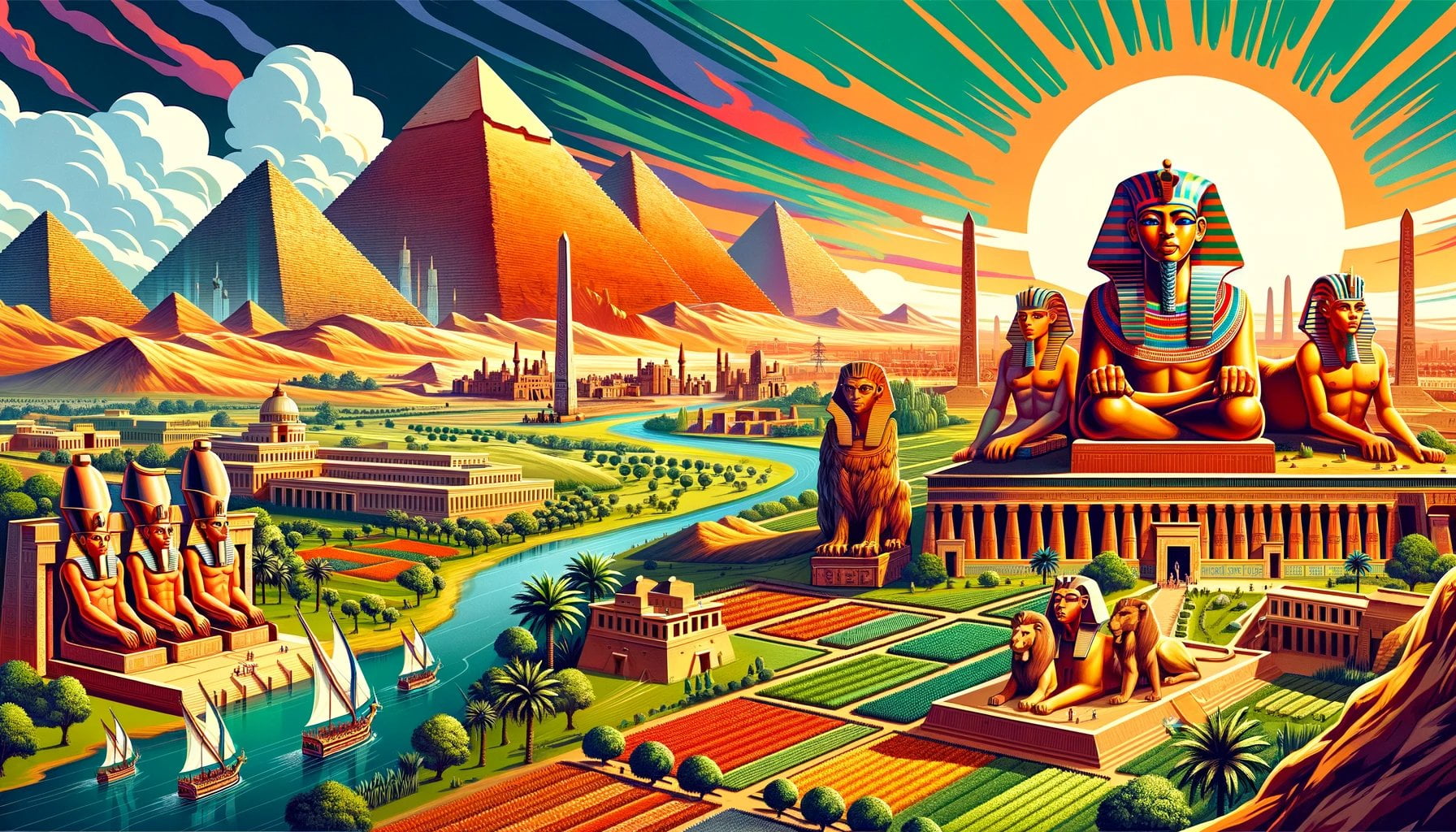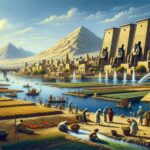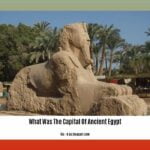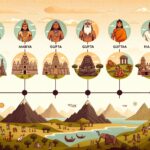The Three Kingdoms of Ancient Egypt: Unveiling the Nile’s Legacy takes us on a captivating journey through the rich history of the Middle Kingdom, Second Intermediate Period, First Intermediate Period, and the New Kingdom. Delve into the wonders of these remarkable epochs as we explore the art, architecture, religion, and governance that have left an indelible mark on humanity. Join us as we unravel the mysteries of the Nile Valley’s ancient civilizations and uncover their enduring legacy.
Key Takeaways:
- The history of ancient Egypt is divided into three main periods: the Old Kingdom, the Middle Kingdom, and the New Kingdom.
- Each kingdom had its own specific time period, pharaohs, constructions, and culture.
- The Old Kingdom lasted from 2686 B.C. to 2181 B.C. and included the 3rd through the 6th dynasty.
- During the Old Kingdom, pharaohs were buried in pyramids.
- The Middle Kingdom lasted from 2055 B.C. to 1650 B.C.
- The New Kingdom lasted from about 1550 B.C. to 1070 B.C.
- The Old Kingdom was known as the “Age of the Pyramids.”
- The Middle Kingdom is sometimes called the “Golden Age” of ancient Egypt.
- The New Kingdom marked a period of great military success and expansion for Egypt.
What Are the 3 Kingdoms of Ancient Egypt?

Archaeologists and historians have divided the rich history of ancient Egypt into three distinct periods known as the Old Kingdom, the Middle Kingdom, and the New Kingdom. These kingdoms played a crucial role in shaping the art, architecture, religion, and governance of ancient Egypt. Let’s delve deeper into each kingdom and explore their remarkable legacies.
The Old Kingdom: Age of the Pyramids
The Old Kingdom, spanning from 2686 B.C. to 2181 B.C., marked a time of great achievement and innovation in ancient Egypt. It witnessed the rise of powerful pharaohs, magnificent pyramid constructions, and a highly centralized government. During the Old Kingdom, pharaohs were buried in elaborate pyramids, reflecting their divine status and eternal power. The famous pyramids of Giza, including the Great Pyramid of Khufu, stand as testaments to the architectural marvels of this era.
The Middle Kingdom: Egypt’s Golden Age
Known as Egypt’s “Golden Age,” the Middle Kingdom flourished from 2055 B.C. to 1650 B.C. This period represented a significant resurgence after a period of political instability during the First Intermediate Period. The Middle Kingdom saw the emergence of strong pharaohs who focused on internal reforms, such as improving infrastructure and enhancing the welfare of the people. The arts, literature, and religious practices also thrived during this era, portraying a culture deeply rooted in humanism, compassion, and introspection.
The New Kingdom: Military Power and Expansion
The New Kingdom, spanning from about 1550 B.C. to 1070 B.C., witnessed a glorious period of military conquests and territorial expansion for Egypt. This era was marked by the reign of powerful pharaohs, such as Hatshepsut, Thutmose III, and Ramesses II, who successfully led Egypt to dominate neighboring lands and establish a vast empire. The New Kingdom saw the construction of monumental temples, such as Karnak and Luxor, reflecting both religious devotion and the wealth generated from conquests.
Throughout these three kingdoms, Egypt experienced remarkable advancements in various fields, from architecture and engineering to astronomy and medicine. The achievements of ancient Egypt continue to inspire wonder and fascination in the modern world.
Ancient Egypt’s history is characterized by three remarkable kingdoms: the Old Kingdom, the Middle Kingdom, and the New Kingdom. Each kingdom had its own unique characteristics and contributions, shaping the legacy of ancient Egypt. From the magnificent pyramids of the Old Kingdom to the introspective humanism of the Middle Kingdom and the military might of the New Kingdom, these periods paint a vivid picture of a civilization that left an indelible mark on human history. By understanding the three kingdoms, we can unlock the secrets of ancient Egypt, unveiling the Nile’s extraordinary legacy.
To uncover the intriguing history of ancient Kourion in Cyprus, click on the anchor text “ancient kourion cyprus” here.
Discover the ancient Greek word for warrior and delve into the fascinating depths of their valiant culture by clicking on the anchor text “ancient greek word for warrior” here.
Embark on a riveting journey through the annals of time and explore the lives of famous people in ancient China by clicking on the anchor text “famous people in ancient china” here.
Unveil the mythical tales surrounding the crocodile god in ancient Egypt by clicking on the anchor text “crocodile god ancient egypt” here.
Unearth the secrets of the skilled craftsmen who shaped ancient Egypt’s grandeur by clicking on the anchor text “what did craftsmen do in ancient egypt” here.
Delve into ancient times and discover the captivating allure of ancient pagan names by clicking on the anchor text “ancient pagan names” here.
First Intermediate Period (2130 – 1938 BCE)
During ancient Egypt’s rich and complex history, the First Intermediate Period stands out as a period of turmoil and change. Spanning from approximately 2130 to 1938 BCE, it marked a significant transition from the Old Kingdom to the Middle Kingdom. This era was characterized by political chaos, competing power bases, and a decline in centralized authority.
Causes of Instability:
The First Intermediate Period was a time of upheaval, marred by fragmented rule and competing power bases. The decline of the Old Kingdom, with its centralized government and powerful pharaohs, paved the way for political chaos. The weakening of the central authority led to the rise of regional power centers, with Heracleopolis in Lower Egypt and Thebes in Upper Egypt emerging as the primary power bases.
Dark Period of Vandalism:
This era is often referred to as a “dark period” in ancient Egyptian history due to the widespread turmoil and destruction that occurred. Temples were pillaged, artwork was vandalized, and statues of kings were destroyed. These acts of destruction not only stripped Egypt of its cultural treasures but also represented a significant blow to the country’s political stability and religious practices.
The Power Struggle:
The First Intermediate Period saw several dynasties vying for control over Egypt. It included the Seventh, Eighth, Ninth, Tenth, and part of the Eleventh Dynasties. The power struggle between Heracleopolis in Lower Egypt and Thebes in Upper Egypt was intense, with both regions attempting to assert their dominance. This period witnessed constant power shifts and upheaval as rulers from different regions battled for supremacy.
The Transition to the Middle Kingdom:
Despite the chaos, the First Intermediate Period played a vital role in shaping Egypt’s history. It served as a transitional phase between the collapse of the Old Kingdom and the rise of the Middle Kingdom, which began around 1938 BCE. The Middle Kingdom marked a period of revival and stability, characterized by strong pharaohs, internal reforms, and a reestablishment of centralized authority.
Key Takeaways:
- The First Intermediate Period (2130 – 1938 BCE) was a turbulent time in ancient Egypt’s history, marked by political chaos and competing power bases.
- It followed the decline of the Old Kingdom and preceded the stability of the Middle Kingdom.
- Regional power centers, including Heracleopolis and Thebes, emerged during this period.
- Temples were pillaged, artwork was vandalized, and statues of kings were destroyed, making it a “dark period” in Egyptian history.
- The First Intermediate Period paved the way for the rise of the Middle Kingdom, which brought stability and internal reforms to Egypt.
Sources:
– Britannica: Ancient Egypt – The Old Kingdom
– History Hit: The 3 Kingdoms of Ancient Egypt
New Kingdom (1539 – 1075 BCE)
The New Kingdom, spanning from 1539 to 1075 BCE, was a remarkable period in ancient Egyptian history that witnessed dramatic shifts in power, conquests, and cultural achievements. This kingdom, consisting of the 18th through the 20th dynasty, witnessed pharaohs buried in the prestigious Valley of the Kings, a monumental burial site located on the west bank of the Nile near Luxor.
Ahmose, who reigned from around 1539 to 14 BCE, marked the beginning of the New Kingdom. During this era, Egypt experienced a resurgence of power, military conquests, and territorial expansion. Prominent pharaohs like Hatshepsut and Ramesses II led Egypt to dominate neighboring lands, establishing Egypt as a formidable empire known for its military might.
The New Kingdom also saw a flourishing of art, architecture, and cultural achievements. Pharaohs built grand temples and monuments, showcasing Egypt’s wealth and power. The famous temples of Karnak and Luxor, dedicated to the primary deities Amun and Amun-Ra, represent the grandeur and opulence of this era.
Egypt’s military successes and cultural advancements during the New Kingdom transformed the political landscape and influenced subsequent civilizations. It was a time of great opulence, innovation, and expansion, with Egypt asserting its dominance over other regions and leaving a lasting legacy.
Key Takeaways:
- The New Kingdom (1539 – 1075 BCE) was a significant period in ancient Egyptian history marked by military conquests and cultural achievements.
- Prominent pharaohs like Hatshepsut and Ramesses II led Egypt’s territorial expansion, establishing Egypt as a powerful empire.
- The Valley of the Kings served as the burial site for pharaohs during this kingdom.
- Grand temples and monuments, such as Karnak and Luxor, were constructed, showcasing Egypt’s opulence and cultural advancement.
Sources:
– Ancient Egypt Online. Retrieved from https://www.ancient-egypt-online.com/ancient-egypt-kingdoms.html
– World History Encyclopedia. Retrieved from https://www.worldhistory.org/New_Kingdom_of_Egypt/

FAQ
Q1: When did the Middle Kingdom of Ancient Egypt begin and end?
A1: The Middle Kingdom of Ancient Egypt began around 1938 BCE and ended around 1630 BCE.
Q2: What was the Second Intermediate Period?
A2: The Second Intermediate Period of Ancient Egypt lasted from approximately 1630 BCE to 1540 BCE. It was a time of political instability and foreign invasions.
Q3: When did the First Intermediate Period occur?
A3: The First Intermediate Period of Ancient Egypt occurred between approximately 2130 BCE and 1938 BCE. It was a period of political chaos and competing power bases.
Q4: When did the New Kingdom of Ancient Egypt start and end?
A4: The New Kingdom of Ancient Egypt began around 1539 BCE and ended around 1075 BCE. It was a time of great military success and cultural achievements.
Q5: Who ruled during the New Kingdom?
A5: Ahmose, who ruled from around 1539 BCE to 14 BCE, is considered the pharaoh who began the New Kingdom of Ancient Egypt.
- Unveiling Bernhard Caesar Einstein’s Scientific Achievements: A Legacy in Engineering - July 15, 2025
- Uncover who is Jerry McSorley: CEO, Family Man, Business Success Story - July 15, 2025
- Discover Bernhard Caesar Einstein’s Scientific Contributions: Unveiling a Legacy Beyond Einstein - July 15, 2025


![A Journey Through Time: Exploring Ancient Egypt's Remarkable 31 Dynasties [ancient egypt history is divided into 31] ancient-egypt-history-is-divided-into-31_2](https://www.lolaapp.com/wp-content/uploads/2023/12/ancient-egypt-history-is-divided-into-31_2-150x150.jpg)












